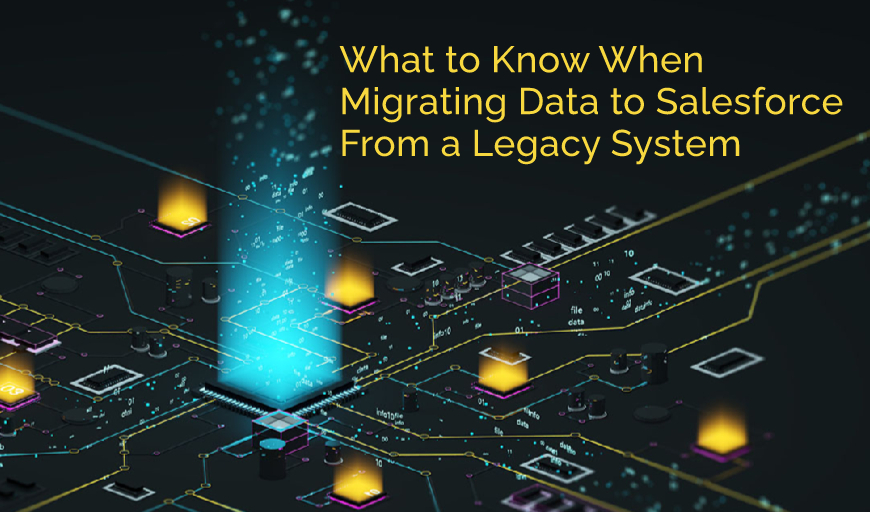What to Know When Migrating Data to Salesforce From a Legacy System
Estimated reading time: 4 minutes
It won’t surprise anyone to know that migrating data from a legacy system to a Salesforce® solution requires some careful planning and execution. And after you’ve chosen your Salesforce migration partner, there are a lot of things to take into consideration. Thus, the reason for us reaching out to Salesforce Lead Technical Architect Richard MacDonald to get his expertise, guidance and some tips. What follows are some highlights from our recent conversation with Richard on the AdVic® “Salesforce Simplified” podcast.
Understanding Your Data
We started our conversation by asking Richard what people need to keep in mind when they’re going legacy to a Salesforce solution regarding the data:
“I think the first thing to really call out here,” Richard remarked, “is the length and breadth of Salesforce as a platform means that you could be having solutions for obviously sales or service or marketing, any other areas. So, the first thing you want to know is what data are you even trying to migrate, right? Is this active customer information? Is this potentially more financial related information? Is it more marketing related information? That sort of thing. So, it’s definitely good to get an idea of, well, what is the actual data I’m moving, and where does it fit into my customer lifecycle?”
Planning Your Migration
We followed-up by asking Richard his thoughts on the important of carefully planning a migration to Salesforce:
“Obviously this can change a lot with the size of migration that you’re going to be performing,” Richard said. “We can have customers that have many hundreds of records of customer information up to enterprises with millions of customer records. So, there’s definitely going to be a cutover point. I know that some companies in the past have tried to run two systems alongside each other, but there’s definitely going to be a cutover point where you’re going to tell your users, okay, hey, access to this system has been cut off because now you’re on this Salesforce solution.
“So, there’s definitely a plan that you are going to want to draft up, a project if you like, around how you’re going to move the information. And then of course, other considerations like any customizations you’re going to make, and then of course, building those and testing those. So, a few different steps.”
Cleaning Your Data
Some might say that cleaning your data when you’re going from a legacy system to a Salesforce solution might just be the biggest step in the process. And that might actually scare a lot of people, so we asked Richard what should be taken into consideration for this step:
“Yes, it could definitely sound very scary,” Richard remarked. “And I think that many people with experience of systems, whether it’s Salesforce or other legacy systems, as time goes on, your requirements change, things change, your data entry points change, and as a result, you can have bad quality data there just from different phases of what you’ve used the system for. So, it’s very important to clean the information because essentially when you’re moving to a new setup, especially with Salesforce, where we have data validation requirements around which information is required to be there, it really is a best practice to ensure that your data is in a consistent and clean format before being moved across.”
Training Your Users
Many people talk about the struggles that they encounter with adoption after a migration. So, when it comes to training your users, Richard stressed the importance of this step:
“It’s critical,” Richard exclaimed. “You’re going to have a length and breadth of users, some of which are familiar with the general UI of Salesforce, and some of which are not. So, obviously you want to make sure that anyone who is starting to use a Salesforce solution has a good understanding of what they’re going to be doing. Now we have a free to use learning platform called Trailhead, which is absolutely amazing for learning some of the core Salesforce features and functionalities.”
Listen to the full “What to Know When Migrating Data to Salesforce From a Legacy System” podcast.
Is your business considering a Salesforce implementation? You will want to seriously consider a consultant who is not just interested in building your next project but wants to build your business for future success. The AdVic team, which is 100% U.S.-based and works on your hours, is ready to start your project today. Reach us here.
Related Resources:
Equipment Manufacturer Replaces Legacy Systems and Thrives
What to Know When Migrating Data to Salesforce From a Legacy System (Podcast)
Subscribe to the AdVic Salesforce Blog on Feedly:



